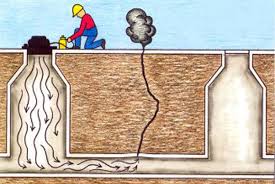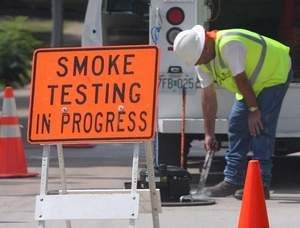Wednesday, January 20, 2021 – Please be advised that the District will be conducting smoke-testing on Mountain Heights and Helgesen on Thursday, January 21st and Friday, January 22nd.

While the District has connected with local residents who may be impacted, to help explain what this means, we have prepared this list of Frequently Asked Questions.
If we have not answered your questions below, please let us know by contacting the District by phone at 250.642.1634 or email at info@sooke.ca.
Smoke Testing Frequently Asked Questions (& Answers)
What is smoke testing?
Field crews blow air and smoke into the sanitary sewer systems in the street and monitor where the smoke escapes. The smoke under pressure will fill the main line as well as any connections and then follow the path of any leak to the ground surface, quickly revealing the source of any problems.
What is the purpose of sanitary sewer smoke testing?
The purpose of smoke testing is to find potential points of inflow and infiltration in the public portion of the sanitary sewer system that could lead to high flows during storms and snowmelt events. Smoke testing can also help locate the following:
- Buildings that have downspout, cellar, yard or basement drains, and sump pumps
- Points of groundwater or surface water intrusion into the sewer
- Any cross-connections between sanitary sewers and storm drains
- Defective sewer connections that could allow sewer gases into a building
What should I do to prepare for smoke testing?
When you receive notice that smoke testing will take place, you should check to see that all drain traps under basins, washing facilities and floor drains contain water; simply flush toilets and run or pour water into all drains, including unused fixtures and floor drains.
Will smoke testing of the sewers allow smoke to get into my home?
No, provided that your plumbing is installed and functioning properly, and provided “traps” are filled with water. Drains that are used frequently should be okay. If you are not sure, simply run water down the drain for a minute to ensure that the trap is not dry. It is important to locate dry traps as they could allow sewer gases to enter the home. Dry traps are most commonly found in basement floor drains that are used only during rare flood events or in unused fixtures. Please thoroughly check your home.
If smoke enters my home, should I be concerned for my health?
No, Hurco LiquiSmoke in smoke form is completely safe and non-toxic. There are NO harmful chemicals in this product.
Can the smoke set off smoke alarms?
Yes, it can set off smoke alarms in large concentrations. If the smoke is setting off alarms, you likely have a plumbing issue, open the windows and doors and air out the room.
How may the smoke enter my house?
Since plumbing fixtures in your home or business are connected to the sanitary sewer system, there is the potential for smoke to enter if the drains are not connected properly. This happens particularly under the following circumstances:
- The vents connected to your building’s sewer pipes are inadequate, defective or improperly installed
- The traps under sinks, tubs, basins, showers and other drains are dry, defective or improperly installed
- The pipes, connections or seals in the wastewater drain system in and/or under your building are damaged, defective, have plugs missing or are improperly installed.
What should I do if smoke gets into the house?
Smoke will probably not enter your home; however, if it does:
- Do Not Become Alarmed.
- Open windows to allow ventilation and note the location of the smoke emission; smoke will clear within a few minutes.
- Exit the building and notify the smoke testing personnel in the area.
What happens if the inspection crews find a faulty sewer or lack of water traps in a home?
If smoke is seen within a house or structure, our crews will attempt to notify the homeowners of these potential defects. Owners will be responsible for repairs to private property plumbing.
Do I have to be home during testing?
No, Inspection crews will not need to enter your home if smoke is present.
How will I know if smoke enters my house if I am not home during testing?
The purpose of the smoke test is to identify sources of unauthorized water entering the public portion of the sewer system. While it is also beneficial to note deficient plumbing connections on private property, this is not the main intent of the smoke test. It is the homeowner’s responsibility to maintain private plumbing connections.
How is a plumbing trap supposed to work?
The “gooseneck” or “snake” section of your drainpipe is the “trap.” The trap allows water to fill that section of the pipe completely. Since vapour and gas cannot travel through water unless under pressure, this effectively “traps” the gas in the sewer portion of the pipe. The vent on your system— the portion of pipe protruding from the roof of the building—prevents the gas from becoming pressurized and allows it to escape outside the structure. These two systems function together to keep sewer gases from entering your structure. If there is no water in the trap, the trap is not functioning properly and can allow smoke to enter your dwelling. We recommend dumping water into building drains and fixtures prior to testing.
Field crews blow air and smoke into the sanitary sewer systems in the street and monitor where the smoke escapes. The smoke under pressure will fill the main line as well as any connections and then follow the path of any leak to the ground surface, quickly revealing the source of any problems.
The purpose of smoke testing is to find potential points of inflow and infiltration in the public portion of the sanitary sewer system that could lead to high flows during storms and snowmelt events. Smoke testing can also help locate the following:
- Buildings that have downspout, cellar, yard or basement drains, and sump pumps
- Points of groundwater or surface water intrusion into the sewer
- Any cross-connections between sanitary sewers and storm drains
- Defective sewer connections that could allow sewer gases into a building
When you receive notice that smoke testing will take place, you should check to see that all drain traps under basins, washing facilities and floor drains contain water; simply flush toilets and run or pour water into all drains, including unused fixtures and floor drains.
No, provided that your plumbing is installed and functioning properly, and provided “traps” are filled with water. Drains that are used frequently should be okay. If you are not sure, simply run water down the drain for a minute to ensure that the trap is not dry. It is important to locate dry traps as they could allow sewer gases to enter the home. Dry traps are most commonly found in basement floor drains that are used only during rare flood events or in unused fixtures. Please thoroughly check your home.
No, Hurco LiquiSmoke in smoke form is completely safe and non-toxic. There are NO harmful chemicals in this product.
Since plumbing fixtures in your home or business are connected to the sanitary sewer system, there is the potential for smoke to enter if the drains are not connected properly. This happens particularly under the following circumstances:
- The vents connected to your building’s sewer pipes are inadequate, defective or improperly installed
- The traps under sinks, tubs, basins, showers and other drains are dry, defective or improperly installed
- The pipes, connections or seals in the wastewater drain system in and/or under your building are damaged, defective, have plugs missing or are improperly installed.
Smoke will probably not enter your home; however, if it does:
- Do Not Become Alarmed.
- Open windows to allow ventilation and note the location of the smoke emission; smoke will clear within a few minutes.
- Exit the building and notify the smoke testing personnel in the area.
If smoke is seen within a house or structure, our crews will attempt to notify the homeowners of these potential defects. Owners will be responsible for repairs to private property plumbing.
No, Inspection crews will not need to enter your home if smoke is present.
The purpose of the smoke test is to identify sources of unauthorized water entering the public portion of the sewer system. While it is also beneficial to note deficient plumbing connections on private property, this is not the main intent of the smoke test. It is the homeowner’s responsibility to maintain private plumbing connections.
The “gooseneck” or “snake” section of your drainpipe is the “trap.” The trap allows water to fill that section of the pipe completely. Since vapour and gas cannot travel through water unless under pressure, this effectively “traps” the gas in the sewer portion of the pipe. The vent on your system— the portion of pipe protruding from the roof of the building—prevents the gas from becoming pressurized and allows it to escape outside the structure. These two systems function together to keep sewer gases from entering your structure. If there is no water in the trap, the trap is not functioning properly and can allow smoke to enter your dwelling. We recommend dumping water into building drains and fixtures prior to testing.
